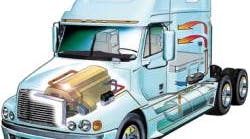Cleaner air benefits everyone, which is one reason why a growing number of communities are willing to share in the cost of voluntary initiatives to reduce toxic emissions, says Peter Rooney, former Secretary of the California Environmental Protection Agency and now an independent environmental consultant. “There are plenty of very sound economic reasons for fleets to reduce engine idling without outside financial incentives,” he notes, “but a fleet's voluntary efforts to reduce vehicle emissions truly do benefit the community as a whole. It's appropriate, therefore, that the general public, the ‘breathers,’ also participate in the costs of these efforts.”
This is good advice, but what do you say when an agency like EPA answers the phone? For starters, there are several major EPA-driven initiatives for improving air quality that lend themselves to idling-reduction programs and projects.
Economic Incentive Programs (EIPs):
-
The Clean Air Investment Fund — provides cost relief when the cost of emission reductions is very high.
-
Open Market Trading — creates transferable emission reduction credits.
-
Financial Mechanisms — may include subsidies to promote pollution-reducing activities or products.
Voluntary Mobile Emissions Programs (VMEPs):
-
Includes a Voluntary Diesel Retrofit Program whereby the EPA works with states and industry to install pollution control devices on existing heavy-duty diesel trucks.
The Ground Freight Partnership Program:
-
Recognizes certain environmental transportation behaviors, such as adopting an idle control technology.
Call or e-mail Paul Bubbosh of the EPA for more information on any of these programs — telephone: 202-564-9322; e-mail: [email protected].
“We've examined the alternatives to idling, everything from auxiliary power units to truck stop electrification, and we believe it is important to inform the trucking industry about ways to reduce their fuel costs while cleaning up the air,” Bubbosh says. “We'd like to take a leadership role, along with our other federal partners (DOE and DOT) to assist in the implementation of idle control technologies and systems.
“Economic incentive programs will have to be negotiated with the appropriate regional EPA office,” he adds, “but we can serve as a resource to assist a fleet or company with their submittal.”
What might all this mean to your operation? If your fleet is considering spec'ing auxiliary power systems or engine-off heaters, for example, you may be eligible for subsidies to offset a portion of the equipment and/or installation costs. California and Texas both have such programs in place right now.
The Carl Moyer Program in California offers fleets up to $1,500 per vehicle toward the installation of devices to reduce idling. (Go to www.arb.ca.gov/msprog/moyer/ for more information.) If the device happens to be a high technology system such as a fuel cell auxiliary power unit, then the subsidy jumps to $2,500 per truck. The main requirement is that the device be used within the state of California for a minimum of 100 hours per year for five years.
In Texas, a new statewide Texas Emissions Reduction Plan (TERP) was recently passed in the state senate. Among other things, TERP is intended to provide approximately $103.6 million annually for heavy-duty diesel emission reductions, including incentives for the purchase of cleaner vehicles. For details, go to www.capitol.state.tx.us/ and use the “search” function to locate Senate Bill 5. The City of Houston also has its own separate clean air initiatives under way. Check Houston's web site for more information: www.ci.houston.tx.us/citygovt/mayor/clean air.pdf/diesel/pdf.
The Internet is a good place to begin scouting for sources of financial or technical support for your fleet's voluntary emissions reduction programs. For example, go to the Clean Cities web site (www.ccities.doe.gov), click on “What's New” and you'll find about 24 pages listing special programs, research, awards, grants and other Clean City initiatives.




